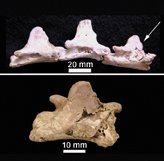Dino bite leaves a tooth
Meat-eating dinosaurs sometimes feasted on flying reptiles.
By Emily Sohn
As the star of Jurassic Park III, the spinosaurus dominated the screen, displaying a huge sail on its back and baring distinctive teeth. Millions of years ago, this large, meat-eating dinosaur may have hunted fish. Its long snout and narrow jaws resemble those of modern, fish-eating crocodiles.
Now, it looks like fish weren’t the only animals on the spinosaur menu. Paleontologists from France recently uncovered fossil evidence in northeastern Brazil that spinosaurs also may have feasted on flying reptiles.
 |
|
The tip of a spinosaur tooth (arrow in top image and shown in bottom image) stuck in a pterosaur neck bone suggests that spinosaurs sometimes preyed upon or scavenged the remains of flying reptiles.
|
| Hipkin, Eric Buffetaut |
The scientists found three fossil neck bones, buried in rocks that are about 100 million years old. One of the bones had a piece of a tooth sticking out of it.
The neck bones belonged to an ancient flying reptile called a pterosaur. The animal was probably about 3.3 meters long from wingtip to wingtip.
The tooth fragment found in its neck was about 1 centimeter long. It was shaped like a cone, and its enamel coating was smooth and thin.
Based on these features, the researchers suggest that the tooth belonged to a type of spinosaur called Irritator challengeri. This spinosaur typically grew to be 10 meters long, walked on two feet, and ate meat.
Paleontologists had previously found remains of fish scales in the stomachs of ancient spinosaurs. And some researchers had unearthed a spinosaur that apparently had eaten parts of a young plant-eating dino. The new finding shows that flying reptiles were also on the menu.
The researchers still don’t know if the spinosaur killed the pterosaur or just chomped on one that was already dead. Either way, the predator probably didn’t mind losing a bit of tooth. Spinosaurs were constantly replacing their teeth.







